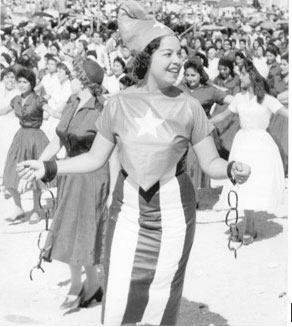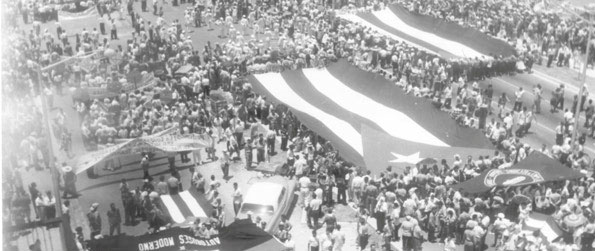Sixty-five years have passed and for the million Cubans who participated in that magnificent parade it was an unforgettable experience. It is difficult to reflect the collective experiences and the great emotions that led a million Cubans to fill the then Civic Plaza, later renamed José Martí Revolution Plaza.

That is why I decided to personalize them based on the memories of a simple graphic worker -my father- who often recalled that day. Like so many other workers, he arrived there at night, with his co-workers, thinking that the Plaza would be practically deserted and they were surprised by the number of people who had already gathered, brimming with patriotism and enthusiasm to celebrate May 1st in Freedom.
The light of dawn had barely appeared and already the immense space became small. Many things would happen that day that had never been seen before: for the first time the workers did not take to the streets to demand their rights, but to express their support for a Revolution that was taking its first steps, but that had already begun its work of justice for which so many had given their lives, their best friend among them, a clandestine fighter.
How he would have loved that party atmosphere! Surely he would have joined one of the congas that were sweeping their way to the grandstand.
How he would have loved that party atmosphere! Surely he would have joined one of the La CongaThe conga is a popular Cuban dance of African origin that has a syncopated rhythm and is accompanied by drums that were sweeping their way to the grandstand.
And he felt that they were together that day, enjoying the immense satisfaction of the conquered victory, laughing at the witty slogans that sprouted from everywhere, admiring the people’s initiatives, like that huge model with the figure of Fidel holding in his hands a sample of the work of the Revolution?
It was known that he was not going to be physically present at that May 1st parade because he was on his way to Buenos Aires to participate in the Conference of the 21. But he thought, smiling to himself, that Fidel was very much Fidel and could not fail to communicate with his compatriots even if it was, as it happened, in a sui generis way.
He heard it on Radio Rebelde on April 28, when the popular announcer Eddy Martin announced that the Commander in Chief would give an interview on board the Libertad plane he was traveling in, which at that time was flying over the Cuban archipelago. He still remembers the first words he addressed to his countrymen: «From here, three days in advance, I want to express our sympathy and solidarity with the workers of Cuba, and we hope that on that day not only the workers will gather there, but also all the people, because Workers’ Day should be the day of all the people?
And he was quite right, he said to himself. It was enough to look around to corroborate it: on that May 1st workers, peasants, students, intellectuals… and another fact that had never happened before in a country where the military had always been the support of the powerful: for the first time they marched together with the workers wearing the glorious olive green uniform, symbol of triumph.
During the march he learned that not only Havanans but also people from neighboring western provinces had gathered there, and he was told that there were those who came on horseback from their rural areas to be present at what became a celebration of all.
The parade went on for 14 hours, in an advance that seemed to have no end, always compact, always combative, and within it he felt he was the protagonist of an event that was also happening for the first time: people and government were merged into one.

The words of the summary of the event were pronounced by Raúl no less than in the early hours of the morning of the 2nd. From his extensive speech, which was focused on unity, like those delivered that day by Che in Santiago de Cuba and Camilo Cienfuegos GorriaránCuban revolutionary fighter who was an expeditionary at the Granma Yatcht. One of the fundamental pillars of the armed struggle that overthrew the tyranny of dictator Fulgencio Batista on January 1, 1959. The plane on which he was traveling disappeared on October 28, 1959 on a trip from Camagüey to Havana and was never found in Camagüey, he was struck by an expression of Raúl inspired by Martí’s poem Yugo y estrella: «To stay here is to be as we have lived until now. There we have a star. To reach it we have to sacrifice ourselves. Here we have a yoke. To reach it, the only thing to do is to submit once again. What do you Cubans want, the yoke or the star? And from his voice came the same cry that burst forth from the crowd: the star, the star!